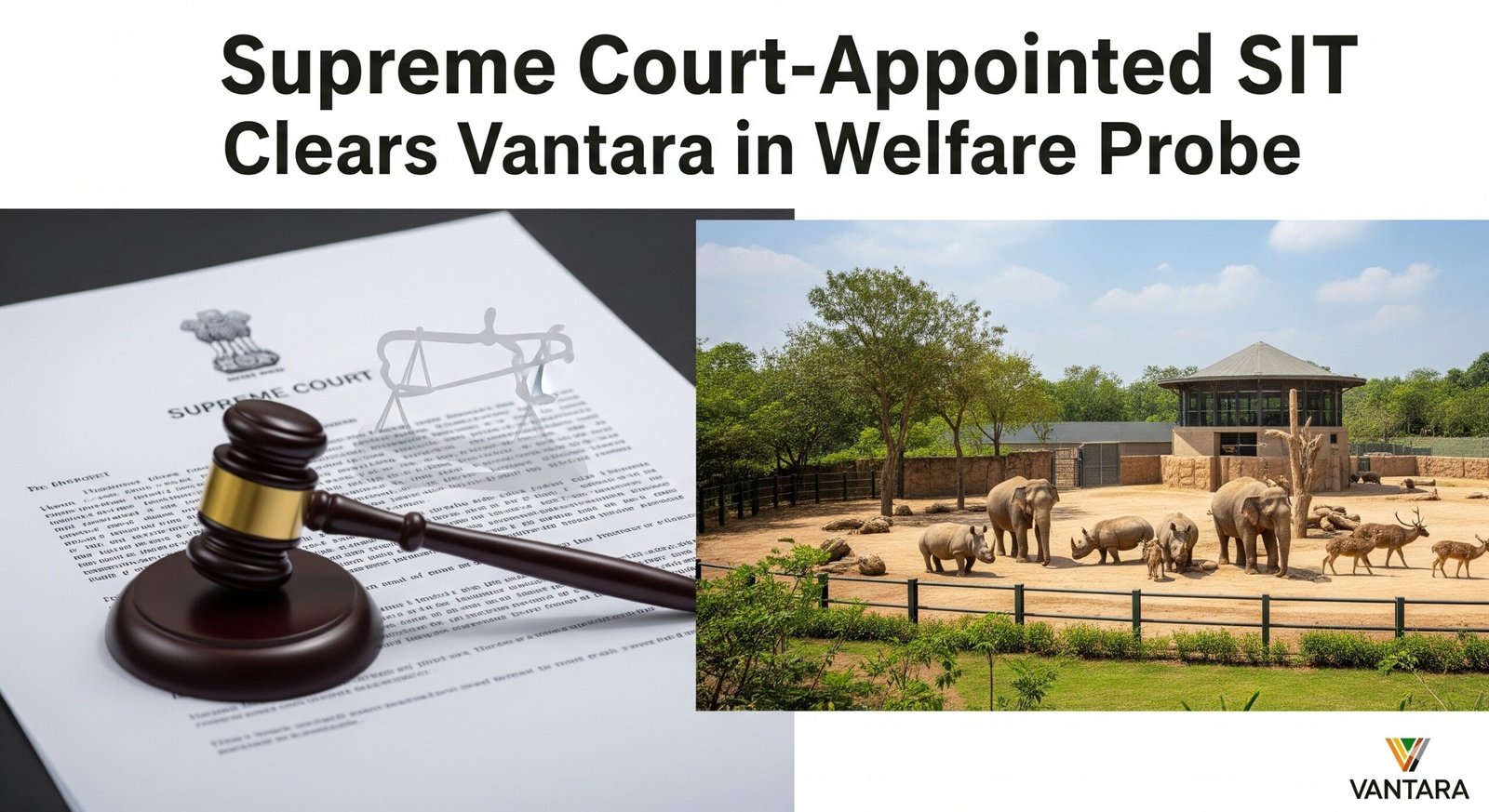Supreme Court-Appointed SIT Gives Clean Chit to Vantara
In a significant development, the Supreme Court-appointed Special Investigation Team (SIT) has given a clean chit to Vantara, the high-profile animal welfare and rescue initiative, after months of inquiry into allegations related to land use, funding, and compliance with environmental laws. The decision marks a crucial turning point for the project, which has been under intense public and political scrutiny since its inception.
Background of the Case
Vantara, which means “star of the forest”, is a large-scale animal rescue and rehabilitation initiative that came into the spotlight for its ambitious conservation efforts. Spread across hundreds of acres, the facility houses rescued elephants, big cats, reptiles, and several endangered species.
Despite the positive publicity, concerns were raised in early 2025 over whether land acquisition processes and environmental norms were fully adhered to. Multiple petitions filed in the Supreme Court alleged that parts of the land used for the sanctuary were ecologically sensitive, and some claimed the project had bypassed approvals under the Wildlife Protection Act and the Forest Conservation Act.
To address these allegations, the Supreme Court constituted a Special Investigation Team, comprising retired judges, environmental experts, and senior bureaucrats, with a mandate to investigate all aspects of the project, from land use to funding transparency.
Findings of the SIT
After an exhaustive review spanning nearly six months, the SIT has now submitted its report to the apex court. The key findings include:
- Compliance with Environmental Laws
The SIT noted that Vantara had obtained necessary environmental clearances before commencing large-scale operations. It also highlighted that the project had voluntarily created buffer zones to protect local biodiversity, going beyond statutory requirements. - Legitimacy of Land Acquisition
Contrary to allegations, the SIT found no evidence of irregularities in land acquisition. The land parcels were reportedly purchased through transparent transactions and did not fall under protected forest areas. - Use of Funds
The committee examined the financial records of the project and concluded that the funding was entirely legitimate, with no diversion of corporate resources in violation of company law or tax regulations. - Contribution to Conservation
Importantly, the SIT praised Vantara for its contribution to wildlife rehabilitation, citing the rescue of more than 300 elephants and hundreds of other animals in distress. The initiative was also credited for creating awareness and providing veterinary care of global standards.
Supreme Court’s Reaction
The Supreme Court bench, which had been monitoring the case, acknowledged the SIT’s report and observed that no wrongdoing had been established. While reserving its final remarks, the court noted that Vantara had faced “unwarranted vilification” despite operating within the law.
The bench also emphasized that large-scale conservation projects must maintain the “highest standards of transparency” to avoid public mistrust in the future. It directed Vantara to continue submitting annual compliance reports to the Union Ministry of Environment, Forest and Climate Change.
Relief for Vantara
For Vantara, the clean chit comes as a major relief. Over the past year, the initiative has been the subject of both praise and controversy. While animal rights groups lauded its mission, critics accused it of being a “greenwashing exercise” to mask corporate expansion.
Officials from the project welcomed the SIT’s findings. In a statement, a Vantara spokesperson said:
“We are grateful to the Supreme Court and the SIT for their impartial investigation. Vantara remains committed to rescuing, rehabilitating, and providing world-class care for animals in need. This verdict strengthens our resolve to expand conservation initiatives responsibly.”
Broader Implications
The case highlights the delicate balance between private initiatives in conservation and regulatory oversight. India’s legal framework for wildlife protection is stringent, but private entities have increasingly stepped in to complement government efforts.
Experts believe the SIT’s clean chit could encourage other corporations to invest in conservation without fear of prolonged litigation, provided they follow due process. However, some activists remain cautious, arguing that constant vigilance is necessary to ensure that projects do not unintentionally harm local ecosystems.
Looking Ahead
The Supreme Court is expected to deliver its final observations in the coming weeks, though no adverse action is likely after the SIT’s comprehensive clearance. Meanwhile, Vantara has announced plans to expand veterinary outreach programs and partner with global conservation bodies.
At a time when India faces rising challenges in biodiversity loss and human-animal conflict, the clean chit to Vantara may pave the way for stronger public-private collaboration in wildlife conservation. Yet, as the court itself noted, transparency and accountability must remain non-negotiable pillars of such initiatives.





